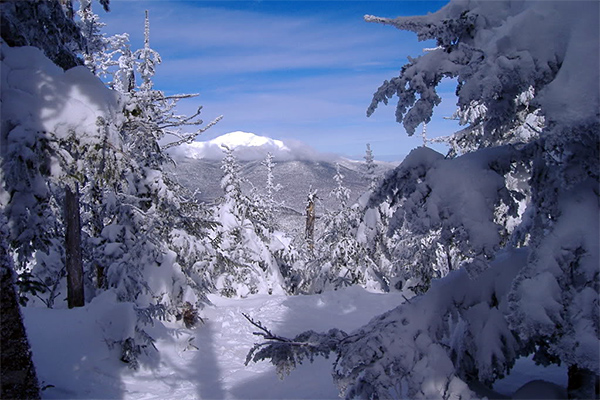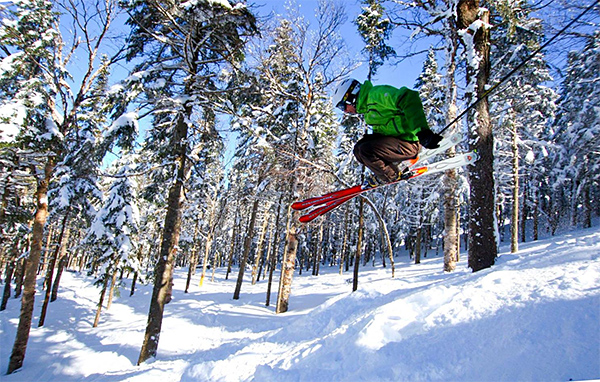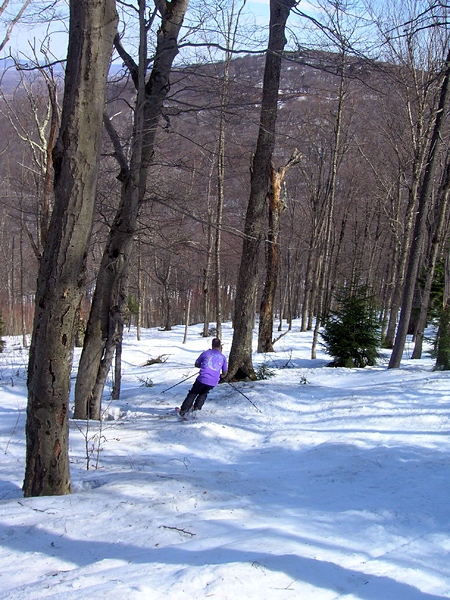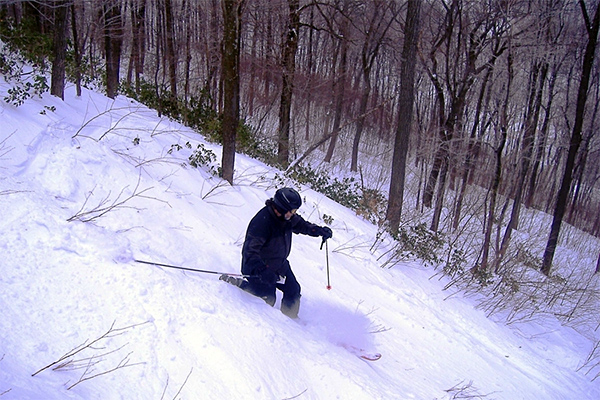What’s so great about glade skiing? Is it the adrenaline rush of a high speed slalom through the trees or maybe the seductive siren song of better, softer snow? Is it the novelty of an alternate dimension offering the chance to escape groomer-bound crowds to a secret, pristine snowriding playground? Maybe part of it is simply supply and demand? Here in the mid-Atlantic glade/tree skiing is not always a given and what we get can be highly ethereal due to sparse natural snowfall. Whatever the draw, it is clear that for many folks glade skiing is the holy grail of Ullr’s winter domain.

|
|
Pristine view from the trees at Wildcat, New Hampshire. Photo provided by Jim Kenney.
|
Personally, as a veteran of 45 ski seasons glade skiing represents a relatively new frontier for me. I’m not particularly adept at glade skiing. It wasn’t generally sought-out or even allowed during my formative years of the 1960s-1980s, especially in the mid-Atlantic where exploring off-piste terrain not served by snowmaking was either infeasible or forbidden and could get your ticket pulled. Now widely promoted in the 21st Century, I find glade skiing to be a fun challenge over cruising groomers and often less punishing than mogul skiing, provided you don’t kiss a conifer.
Glade skiing can range from fairly open, low angle terrain of intermediate level difficulty to super expert stuff depending on gradient, tree density, and rate of attack. Steep, tight glades peppered with rough cut bumps and having no end in sight can be some of the most intimidating terrain you’ll ever face. This past March I was in one of the premier tree skiing spots on the East Coast, Casablanca Glade at Saddleback, ME. I saw several six foot ramps set up deep in Casablanca’s woods. Skiers or snowboarders who successfully launch for big air in the close confines of a thick, black diamond glade like Casablanca with little open landing space impress (and scare) the heck out of me.

|
|
Nice Air in 44 acre Casablanca Glade, Saddleback, Maine. Photo provided by Saddleback Ski Area.
|
Besides the thrill of a slalom course laid out by the Almighty Himself, tree skiing presents additional unexpected terrain features that enrich the ski experience and spur you to “up” your game. While exploring gladed terrain I’ve encountered frozen waterfalls at Mad River Glen and Smuggler’s Notch, VT, unmarked cliff drops at Alta and Brighton, UT, secluded clearings at Keystone, CO and Wildcat, NH with rapturous mountain views, and plenty of playful obstacles like stumps (punji sticks), logs, and rocks at Blue Knob, PA and Timberline, WV. Within ski area boundaries, monitored by ski patrol, and reasonably safe, the best gladed terrain can add big excitement, challenge, and adventure to resort skiing.

|
|
Timberline, WV offers a rare commodity in our area, spring glade skiing as demonstrated by DCSkier “SCWVA”. Photo provided by Jim Kenney.
|
On the other hand, when a resort’s groomers and mogul runs suffer from bulletproof frozen surfaces, nearby tree runs sheltered from the damaging effects of wind and sun can sometimes provide the “easiest way down” with softer, more enjoyable snow conditions. A trip through a low angle glade with widely spaced trees like the Zip Basin area off chairlift #8 at Loveland, CO can be a big confidence builder for intermediates and provide a fun ski lesson through creativity and variety. If visibility is really poor due to fog or falling snow the trees are a good place to go for the contrast and definition they offer. And as all powder hounds know, glades can hold freshies long after regular trails have been scraped bare.
Glades are generally a good choice for crowd avoidance. The feeling of exploration can be fun and liberating. However, I don’t recommend that they be skied solo due to the dangers of buried logs, low hanging branches or intransigent tree trunks. Skiing gladed areas alone out West or in remote parts of the Northeast is especially hazardous due to the risk of falling into a tree well or wandering off into unpatrolled and unfamiliar wilderness beyond ski area boundaries.
Possibly my greatest glade skiing experience was the month of February 2010 right here in the mid-Atlantic at Blue Knob, PA. That was the year of the Snowpocalypse and I got in about five days of “boundary to boundary - everything open” skiing that was as much fun as I’ve ever had at my favorite local hill. The whole mountain came alive and I skied stuff that month I had never skied before in my approximately 350 lifetime ski days at Blue Knob since 1967. Ski good or eat wood!
I close this homage to glade skiing by rephrasing Rod Serling’s intro to his classic 1960s television series, The Twilight Zone. When you drop into the trees you’re traveling through another dimension -; a dimension not of man made snow and groomers, but of the all-natural and the untamed. A journey into a wondrous land whose boundaries are that of the skier’s imagination. That’s a trail sign up ahead, your next run: the Glade Zone!

|
|
Rod Smith in the zone at Mineshaft Glade, Blue Knob, Pennsylvania. Photo provided by Jim Kenney.
|
Selected Mid-Atlantic Tree Skiing Spots *
(*: At any given time glade skiing may or may not be permissible at these ski areas. Consult local knowledge/authorities prior to skiing unmarked terrain. Don’t put yourself or others in danger.)
Blue Knob, PA: When Mother Nature cooperates this is the place for the best and most challenging glade skiing in the region. About a half dozen glades are designated on the trail map from dark blue to double black diamond in difficulty, but even more acreage comes into play under the right conditions. Blue Knob generally has a very permissive attitude about tree skiing.
Timberline, WV: Mother Nature is usually more generous with the white stuff in West Virginia allowing a greater window of opportunity and Cherry Bowl Glade at Timberline offers probably the largest single expanse of lift served skiable gladed acreage within three or four hours of DC. Nice treed areas running adjacent to many trails are also frequently skiable.
Snowshoe, WV: In recent years Snowshoe has opened and officially designated gladed areas served by the Widowmaker Chairlift. I am not that familiar with the glade skiing at Snowshoe, but with its high elevation, relatively hefty seasonal snowpack, and considerable total resort acreage the opportunities must be there
Seven Springs, PA: Seven Springs has a healthy smattering of glade skiing opportunities on both the front and backsides of the trail layout. These pockets of treed terrain benefit from blow-over coverage from the extensive man-made snowmaking system at the Springs allowing guests to sample a taste of tree skiing over much of the season.
White Grass Ski Touring Center, WV: Located in Canaan Valley, WV close to Timberline, snowsports activities at White Grass take place on the valley floor and nearby mountains across an elevation range of approximately 3200 to 4400 feet above sea level. Basically, once you climb out of the valley the whole place is a glade, but there are no ski lifts and you have to earn your turns at this cross-country, telemark, Alpine Touring (AT), and snowshoe center. The total skiable vertical drop is 1200 feet. White Grass made national news by offering early season powder turns as a result of the Hurricane Sandy Halloween Blizzard of 2012.
Husband, father and retired civilian employee of the Department of Navy, Jim Kenney is a D.C. area native and has been skiing recreationally since 1967. Jim's ski reporting garnered the 2009 West Virginia Division of Tourism's Stars of the Industry Award for Best Web/Internet/E-Magazine Article.
There are no reader comments on this article yet.

Join the conversation by logging in.
Don't have an account? Create one here.